Introduction
The idea that creativity and madness are intertwined is a powerful and enduring myth. From Van Gogh’s tortured brushstrokes to Sylvia Plath’s poignant verses, history often paints genius as inseparable from psychological suffering. But this romantic narrative is more complicated — and more dangerous — than it seems.
Read More- Main Character Syndrome
The Myth and the Reality
The tortured artist trope is seductive — it suggests that suffering is a necessary ingredient for brilliance. But this can dangerously glamorize mental illness, discouraging people from seeking help or perpetuating stigma.

- Studies do find a higher incidence of some disorders like bipolar disorder among creative people. But the correlation is not causation.
- Many with mental illness do not exhibit extraordinary creativity, and many brilliant creators do not suffer from any psychiatric condition.
- The idea that mental illness fuels creativity can trivialize the very real pain, disability, and risk of self-harm these conditions cause.
Example:
Kanye West, a globally celebrated artist and producer, has publicly disclosed his bipolar disorder diagnosis. His creativity and influence are undeniable, but his struggles also illustrate the fine line between genius and crisis. Episodes of mania and psychosis have led to erratic behavior, public outbursts, and hospitalization — highlighting the serious impact untreated or poorly managed mental illness can have, regardless of talent or success.
The Science Behind the Link
Three important facts that explains this link include-

- Divergent Thinking and Disorganized Thought- Creativity often involves thinking outside the box, generating many novel ideas — called divergent thinking. Certain mental illnesses may enhance this ability but also increase disorganized thinking, which can impair functioning.
- Dopamine Dysregulation- Dopamine plays a dual role — it fuels motivation and creative insight but also underlies symptoms of psychosis and mania. This neurochemical overlap suggests some shared pathways but does not romanticize illness.
- Heightened Sensitivity- Emotional and sensory sensitivity is common in mood disorders and may deepen artistic expression. However, this sensitivity also makes individuals vulnerable to overwhelming distress.
Historical and Modern Examples
Some scientific historical and modern examples include-
- Vincent van Gogh created revolutionary art amid depression and psychotic episodes, ultimately dying tragically by suicide.
- Sylvia Plath’s powerful poetry was shaped by depression, ending with her early death by suicide.
- Ludwig van Beethoven may have channeled mood swings into his work, but his personal life was marked by suffering.
Today, Kanye West’s story shows how mental illness, creativity, and fame collide, sometimes with devastating consequences. His public struggles remind us that creative brilliance doesn’t shield anyone from the risks of mental health crises.
Creativity
The “mad genius” narrative can dangerously romanticize mental illness, potentially:
- Discouraging treatment by glorifying suffering.
- Obscuring the fact that mental illness can severely disrupt life and creativity.
- Leading to neglect of mental health support for artists and innovators.
At the same time, creative expression can be a powerful therapeutic outlet — but only when paired with proper mental health care.
Busting Dangerous Myths
It’s critical to dismantle the myth that creativity requires madness. Doing so reduces stigma, promotes realistic understanding, and encourages people to seek help without shame.
The real brilliance lies in nurturing mental wellness alongside creativity — not in suffering silently or glorifying instability.
Conclusion
The relationship between madness and masterpieces is complex, fraught with myth, and colored by very real human pain. Mental illness can sometimes coexist with creativity, but it’s no prerequisite — and it’s never something to romanticize.
Figures like Kanye West remind us that behind genius can be vulnerability needing care, not just admiration. The future of creativity depends on embracing compassion, support, and balance — ensuring that brilliance shines brightest in minds that are cared for, not exploited by myth.
References
Kyaga, S., et al. (2011). Creativity and mental disorder: Family study of 300,000 people with severe mental disorder. The British Journal of Psychiatry.
Andreasen, N.C. (1987). Creativity and mental illness: Prevalence rates in writers and their first-degree relatives. American Journal of Psychiatry.
Jamison, K.R. (1993). Touched with Fire: Manic-Depressive Illness and the Artistic Temperament. Free Press.
Kyaga, S., et al. (2013). Mental illness, suicide and creativity: 40-year prospective total population study. Journal of Psychiatric Research.
Subscribe to PsychUniverse
Get the latest updates and insights.
Join 3,027 other subscribers!
Niwlikar, B. A. (2025, June 7). Myth of the Tortured Artist and 3 Powerful Scientific Facts to Explore It Further. PsychUniverse. https://psychuniverse.com/myth-of-the-tortured-artist/



